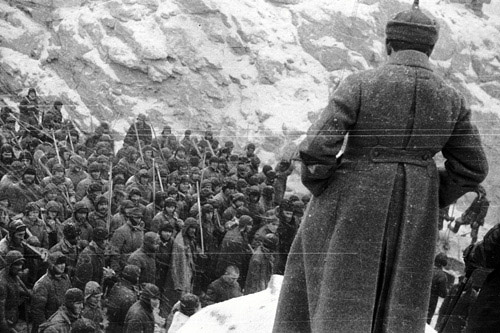When the Bolsheviks came to power Alexander Rodchenko declared painting to be dead and turned instead to photography. Modern, objective, apparently free from the taint of bourgeois subjectivity, photography showed that it could play its part in the dictatorship of the proletariat.
Radical photographic style was combined with cutting edge graphics in a magazine called 'USSR in Construction'. Designed by Rodchenko, it was a showcase of political propaganda glorifying the achievements of the Soviet system. 'USSR in Construction' displays Rodchenko's mastery of photo-montage, a graphic technique that took its cue from cinema montage. Rodchenko's photo-montages treated photographs as raw footage, suppressing their individuality, collectivising their energies, cutting, pasting, re-touching and re-photographing them to conjure up dizzying visions of the future.
Rodchenko harnessed photography to greatest effect in an issue of 'USSR in Construction' devoted to the White Sea Canal, trumpeted at home and abroad as a triumph of Soviet engineering and enlightened Soviet penal policies. The canal would be built by criminals and other social undesirables who would be rehabilitated through labour. Rodchenko travelled to the canal to take the photographs that would provide the raw material for this masterpiece of political propaganda.
"We can see in the Rodchenko book how the original picture looked � rather grey and flat. Of course, the montage is altogether much more successful as a picture. He's able to put in the text, give more impact for the crowd of workers and of course the figure in the foreground gets more impact in the way he has heightened up the contrast between it and the backdrop. You can see all these different components have been put together to make the picture and although when you look at this you wouldn't think its particularly a montage, its only when you see the original, and you see how its changed in its intention and its meaning that you really understand how photo-montaged this is." (Martin Parr, photographer)
But Rodchenko's virtuoso post-production conceals a grim truth. These determined-looking workers were mostly political prisoners and the White Sea Canal, a 140 mile long gulag. And far from being rehabilitated through their labour, 200,000 of them would die as a result of it, a reality that can still be glimpsed in the unsmiling faces of the untouched original.
